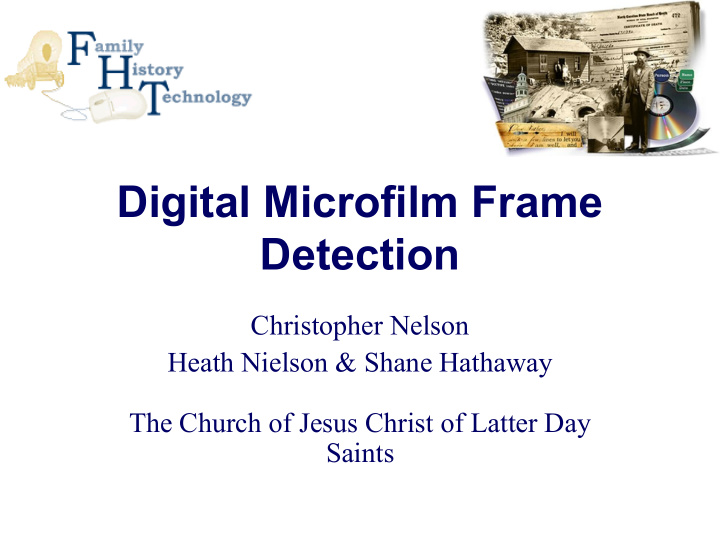



Digital Microfilm Frame Detection Christopher Nelson Heath Nielson & Shane Hathaway The Church of Jesus Christ of Latter Day Saints
Microfilm Frame Detection Scanning microfilm is much like taking pictures: 1. Scan a small strip of microfilm 2. Finish the scan in a place that looks like background 3. Look for a document in that strip and save it 4. Repeat What if the entire microfilm roll was scanned into one extremely large image? How would frame detection work?
Where are the Documents? Why Find Documents? • Saving document images off the film • Indexing microfilm by document number / location • Cataloging microfilm contents Challenges • Documents do not have consistent size • Cluttered film / overlapping documents • Poor microfilm quality / noise • And much more…
Digital Microfilm Frame Detection 1) Generate a Ribbon Profile 2) Set the Threshold a. Generate the “Average Minimum Profile” using a Sliding Window b. Adjust Threshold to Allow for Gradual Changes 3) Mark the Document Segments 4) Detect Horizontal Frame Edges a. Generate Horizontal Profiles b. Set Thresholds using Histograms c. Select the Best Results
Ribbon File Format • Uncompressed 8-Bit Grayscale Image File • Millions of Pixels Long • Average File Size: 20 – 30 Gigabytes • Encoded as a Eight Level “Hierarchal Pyramid” Frame Detection Runs on the 5th Level
Generating the Ribbon Profile Each pixel has a intensity value which ranges from 0 (pure black) to 255 (pure white) Profile : sum of these values for each column Documents = High Profile Values Background = Low Profile Values
Setting the Threshold Threshold : dividing line between document and background profile values 1) Generate the “Average Minimum Profile” using a Sliding Window 2) Adjust Threshold to Allow for Gradual Changes
Marking Document Segments Left and right document edges are found where threshold and profile values match Ribbon segments containing documents occur where the profile lies above the threshold
Detecting Horizontal Frame Edges 1) Generate Two Ribbon Profiles Horizontal Pixel Intensity – sum of pixels in each row Horizontal Pixel Variance – variance for each row of pixels 2) Set Threshold using Histograms Compute a “minimum peak value” Find the minima after first group of peaks 3) Select the Best Results Choose the one which creates the largest frame
Frame Detection Demonstration 1) Generate a Ribbon Profile 2) Set the Threshold a. Generate the “Average Minimum Profile” using a Sliding Window b. Adjust Threshold to Allow for Gradual Changes 3) Mark the Document Segments 4) Detect Horizontal Frame Edges a. Generate Horizontal Profiles b. Set Thresholds using Histograms c. Select the Best Results
How Well Does this Work? Accuracy Based on Microfilm Quality • 91 Good Films: 99.86% • 17 Fair Films: 99.47% • 12 Poor Films: 94.36% For Example…
We’ve Got Frames, Now What? Improving Frame Detection • Detecting Reverse Polarity Frames • Finding Rotation / Mirroring Problems • Separating Overlapping Frames Uses for “Framed” Document Images • Automatically Identifying the Contents of Frame • Cataloging / Indexing Microfilm Ribbons • Saving Document Images for Later Use • Measure Microfilm, Frame, or Document Quality
Questions
Recommend
More recommend